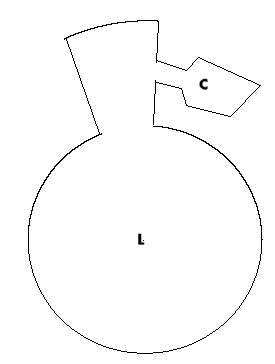Answers
1. My water straw question: nobody got the exact correct response (edit: I see now that Perfection was very close, and Syterion explained more fully). The answer is that the vacuum created in the straw does not "suck up" the water; rather, the vacuum represents a pressure inequality. Outside atmospheric pressure pushes down on the water in the glass, forcing it up into the straw. However, atmospheric pressure can only support its weight in water, which is 34 feet per unit area (10 meters). Thus, no matter how hard you suck, the pressure difference can be no more than 1 atm, and thus using an ordinary straw you cannot suck water up to the third floor.
Trees grow taller than 34 feet because the xylem (water-carrying tubes) within the wood are so narrow (just one cell diameter) that cohesion and adhesion become significant factors, enabling a column of water to be elastically extended beyond 34 feet.
2. Bozo's rocket in a vacuum question: by Newton's Third Law, the momentum of the escaping gases must be equal to the momentum of the rocket (m1v1=m2v2). You talked about "Climbing by pulling on a rope that isnt attached to anything." Great example. If you were to try to climb a rope ladder on the Space Shuttle in null g, you would climb "upwards" a few centimeters at most and the rope ladder would move downwards at a velocity opposite and nearly equal to what yours would be if you were climbing a rope ladder attached to a wall (the heavier the rope ladder, the faster it would move. If it had a mass equal to your own, it would move downward with a velocity exactly equal to your upward climb). In all cases, your collective center of gravity does not change. Similarly, the velocity of the collective center of gravity of a rocket and its exhaust in a zero-G environment must be zero. If you think about the rocket/exhaust combo as a single object with no external forces acting on it, you'll see. Just think of an astronaut trying to swim in space. It isn't possible. Thus, when part of the object goes one way the other must go the opposite direction.
3. Truorian asks: Can you design a room with mirror walls such that no light from a lamp at A reaches a camera at B (where A and B are specified points in this room)?
My intuition on this is to say that according to Feynman's interpretation of quantum tunneling, we cannot exactly predict the path of any photon and thus there is no way to build a perfectly dark container. Just like the famous "double-slit" experiment.
Hmm, thinking about it some more, you can create an elliptical chamber where all light from the source at one focus must pass through the other focus (there was a famous "fixed" billiards table built to this design). Not sure how that helps. And it is a Newtonian interp of photon motion, which we now
know for sure is not correct.
I'm leaning towards this being a trick question


 The fact that light can eminate in a full circle is what makes the problem challenging.
The fact that light can eminate in a full circle is what makes the problem challenging.
 The fact that light can eminate in a full circle is what makes the problem challenging.
The fact that light can eminate in a full circle is what makes the problem challenging.
 ), and I promise you you will move backwards. It's the same reason a gun recoils when you fire it: it's just thrown a small mass very very fast out the front ... and you wouldn't say that part of the bullet hitting you is the reason your arm gets flung back!
), and I promise you you will move backwards. It's the same reason a gun recoils when you fire it: it's just thrown a small mass very very fast out the front ... and you wouldn't say that part of the bullet hitting you is the reason your arm gets flung back! 

